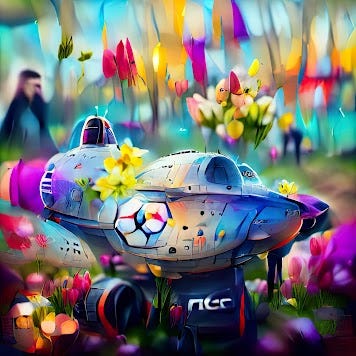AI Image Generation is Having a Moment
From Fine Art to Social Posts to Ads, Lets Talk Hyper-Automation
https://youtube.com/shorts/HkzDZbt042g?feature=share
The image above was created using Lightricks’ new “Generate AI Image” feature in the Motionleap iOS app. It’s free, took less than a minute to type the description “Yorkshire Terrier surfing a big wave in Hawaii,” and generate. Afterward, I used another Motionleap tool to animate the image. That also took less than a minute. You can see the animated version here.
Just a couple of weeks ago, TikTok added a new AI Green Screen generation filter. The idea behind that feature is to enable creators to have more interesting and unique green screen backgrounds that they don’t have to spend any time to create.
Lightricks goes for photorealism because that is its audience. TikTok has more of a vibe that is a cross between impressionist, surrealist, and cubist painting. It is said, we are an image-obsessed culture in the modern West. The speakers of this phrase may have originally meant persona as an image, but the iPhone and now social media eras have turned the abstract idea into an objective reality. Images are everywhere in our time. It’s no wonder AI is now playing a role.
From Art to Ads to Creators
The AI-image generators initally biased toward use for art. There are countless examples. Here is one from artist Anne Spalter. She created 555 spaceships using Night Cafe, turned them into NFTs, and they sold out in about 20 minutes for around $75,000. Since then, another $213,00 in trading has occured on secondary markets.
It didn’t take the artists in ad agencies long to figure out that there was oppotunity in AI-generated images. Heinz produced a commercial recently that showed dozens of images of ketchup bottles produced by OpenAI’s DALL-E.
It’s not surprising that this then migrated to tools for creators. Artists are used to employing media in its raw form and then modifying it. Ad agencies have teams of artists and developers to do the same.
Creators on social media generally need an application that further simplifies the process to adopt a new technology. TikTok and Lightricks won’t be alone. I’d expect to see something for Instagram very soon. It would also make sense for YouTube. Deep Deam Generator from Google’s DeepMind would be a good option.
Hyper-automation and Hyper-creation
I will detail a new thesis around synthetic media in a forthcoming report on the topic. A core idea here is what it means when we automate tasks that previously took humans a great deal of time and cost to complete. AI-generated media is clearly automation but it is best characterized as hyper-automation. We are not talking about something that is three, five, or ten times faster than manual methods. The automation improvements are orders of magnitude faster thus the preferred modifier, “hyper.”
It also has me thinking about the term creation. So many new versions can be created quickly that are all unique and don’t rely on a single person to develop. This is a creativity explosion that only relies on a few words from a human user. With that said, a bot could manage the inputs as well which might further reduce the human time needed. The results of AI-kmage generators provide many more draft concepts for creative directors (and creators) to consider during the creative process. So, hyper-creation also seems like an apt term to describe the changes the technology will bring.
There is no doubt that AI-image generation is changing the economics of image production. It is also changing the creative output as Anne Spalter and Heinz aptly demonstrated. More to come on this topic very soon.
Postscript - Join the Synthedia Event
One more thing. We will be talking more about AI-image generation and the broader synthetic media space at the online Synthedia event coming up on September 14th. Register to join us live or get easy access to the recording afterward. I hope to see you there.






